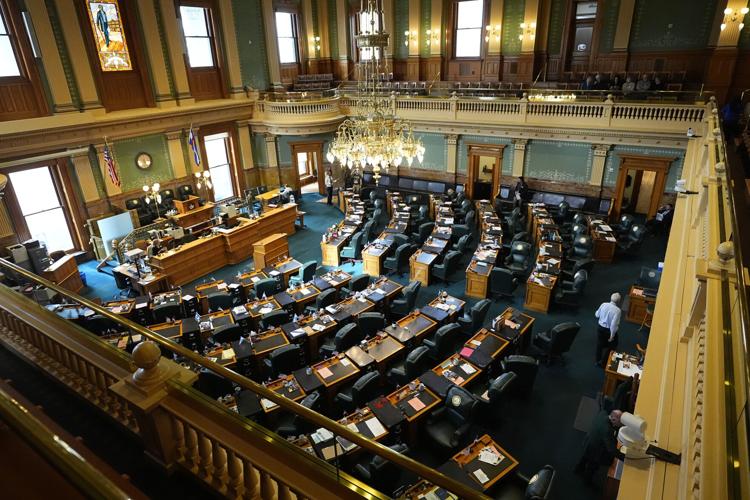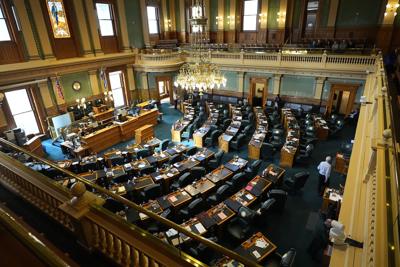Colorado lawmakers face tight pressures as they begin to craft the state's spending plan, which could mean less money available for their priorities in the next fiscal year.
In particular, the state has collected a lot more in "cash" funds.
Here's why that matters: There are about 400 sources of cash funds that go into the state budget. Once the combination of cash and "general fund" dollars goes above the Taxpayer's Bill of Rights limit, the state must use general fund money to cover TABOR refunds mandated by that surplus.
So, the more cash funds grow, the more pressure it puts on "general fund" dollars.
The March revenue forecast — the all-important set of numbers that gives state budget writers their final look at what's available to spend before finalizing next year's spending plan — shows exactly that.
That's not the only balancing act lawmakers have to contend with.
First, legislative leaders earlier promised to pay off what's call the budget stabilization factor — money "owed" to K-12 schools for the years when they didn't get the full amount under statutory formulas.
Second, revenue for the state's "healthy meals" program is coming in less than the demand.
And that's not accounting for new spending that lawmakers would like to pay for.
Rep. Rick Taggart, R-Grand Junction, who is filling in for Rep. Rod Bockenfeld of Watkins on the Joint Budget Committee while Bockenfeld is receiving cancer treatment, said the the 2024-25 budget is going to be "exceedingly tough."
"These projections reinforce that," he said.
All eyes on the Joint Budget Committee
The combination of changes in general fund revenue forecasts and other factors means the decisions made by the Joint Budget Committee in the coming week will determine what lawmakers have to spend on new programs.
That, in turn, could mean lawmakers have to decide between funding capital projects — largely for higher education — and new programs.
Consider this: The forecast outlined by Legislative Council economists show budget writers are going to be short about $266 million below the state's 15% statutory reserve.
The JBC could decide to reduce the statutory reserve to below the current rate or reduce capital spending to keep the reserve — the state's rainy day fund — at its 15% level.

What are cash funds?
Cash funds can only be used for the purposes designed by state law. For example, license fees paid for by hunters and anglers are considered cash funds and can only be used for the state's Parks and Wildlife.
The largest source of cash funds in the state is college tuition, although those dollars have been exempted from the TABOR calculations for the past 20 years and are designated as an "enterprise," a kind of state-owned business.
The cash funds with the biggest growth through January 2024 are transportation fees, the majority of it from the road users fund set up through Senate Bill 21-260, the massive measure aimed at funding, upgrading and maintaining, as well building up Colorado's transportation structure.
Those fees generated $185 million more in 2023-24, economists said.
Indeed, transportation fees are now the largest source of cash funds subject to the TABOR revenue limits.
That infusion of cash means going over the TABOR limit, and the more lawmakers have to send back to taxpayers through TABOR refunds, the less they have for the 2024-25 budget.
Note that while the state budget is made up of cash funds, general fund dollars and federal funds, it's general fund dollars that are discretionary and what's available for lawmakers to spend on new programs or increased costs for current ones.
"The most important determinant of the budget is your decision-making," chief economist Greg Sobetski told lawmakers.
Pessimism and optimism
The forecast from the governor's Office of State Planning and Budgeting is more optimistic.
"We enjoy the partnership — and the competition — with the Legislative Council," OSPB Director Mark Ferrandino said.
A comparison of the two forecasts showed that, for 2023-24, which affects the 2024-25 budget, OSPB estimated state general fund revenues at $251 million higher than the Legislative Council projection. (OSPB's estimates for general fund revenue are also higher for 2023-24 by $308.7 million than its December estimate.)
That might mean that the JBC uses the OSPB revenue numbers to estimate the budget, which is common when OSPB's numbers come in higher.
While the state isn't in a recession, people feel like it is, added Bryce Cooke of OSPB. People expect an overall slowdown in consumer spending that will cool GDP growth, Cooke told the committee.
While OSPB is optimistic about its budget estimates, it is worried about the potential for a recession, based on supply chain problems, higher shipping costs, continued high interest rates, more consumer debt and lower levels of government spending, coupled with the potential for a partial federal government shutdown.
"The issue isn't 'if' we see a recession,' it's 'when' we see a recession," Ferrandino said.
The OSPB director most recently served as executive director of the Department of Revenue, but his history also includes eight years in the House, including as House Speaker and four years on the Joint Budget Committee.
The state's 2024-25 budget is scheduled to be introduced in the House on March 25, but the March 14 snowstorm, along with other activities that have delayed the work of the Joint Budget Committee, could push that back.
Passing a balanced budget is the only constitutional requirement made of lawmakers.
TABOR refunds
TABOR refunds are likely to change in the next few years.
The refunds to be paid in April will total $3.67 billion, most of that through the six-tiered sales tax refund ($3 billion). All refund mechanisms will be in play this year, including the higher earned income tax credit approved in the November special session, a property tax refund approved in 2022, and the senior and disabled veterans homestead exemption.
In the outyears, only the sales tax and senior/veterans property tax exemptions will be available. The TABOR refunds are forecasted to drop by more than $1 billion next year and by almost $1.8 billion the following year.
Here's the differences between the OSPB and Legislative Council forecasts: OSPB predicts the state will have $216 million above the 15% statutory reserve, compared to JBC's estimate it would be $266 million in the red — or would be required to reduce the reserve in order to cover expenditures.
Healthy meals funding isn't so healty
Another problem for budget writers is that revenue for Proposition FF, the "healthy meals for all" ballot measure from 2022, isn't keeping up with its demand, based on projections from the state Department of Education.
OSPB estimates the program will be short $10 million to $15 million.
The program's revenue is derived from higher income taxes on individual earnings above $300,000 annually.
"We will have some work to do to prioritize," said Rep. Shannon Bird, D-Westminster, who serves as JBC chair.
As for lawmakers who have bills camped in appropriations committees totaling more than $500 million, Sen. Barbara Kirkmeyer, R-Weld County, offered this message: "Keep camping."
"We have hard work to do to make sure this budget reflects the needs of the people of our state, work they expect us to do," Bird added.
"We understand our colleagues have important legislation they want to bring forward," she said, adding the JBC will work hard to see that the high priority needs are taken care of.
In both forecasts, there were assumptions based on the November 1 governor's budget, noted vice-chair Sen. Rachel Zenzinger, D-Arvada.
"There's money in there for bills, but that's really not our concern."
What about money for schools?
The committee's concern is twofold: ensuring the budget stabilization factor is paid off, a decision the committee made several weeks ago, addressing workforce gaps and funding higher education.
"None of what we heard today jeopardizes fully funding K-12," Bird said. "Our commitment to investing in our schools is rock-solid."
That also applies to commitments to higher education, she said.
The JBC want's to make sure the state won't find itself again in the position of creating a "debt" to K-12, Kirkmeyer said.
What concerns her about the forecast, she said, is what will happen to the state education fund in the next five years.
The OSPB forecast projected the balance in 2023-24 at $1.6 billion, but estimates say it will drop precipitously in the next few years, drawing it down to $150 million by 2027-28.
Her worry is that legislators, governors and state agencies will become overly dependent on general fund dollars in order to grow government.
If government continues to grow, when property taxes start to decline — and they will should voters approve a ballot measure in November that would cut property taxes — the school districts that rely on property taxes will have to turn to the state to cover the shortfalls, she said.
State law requires that general fund dollars backfill property tax shortages.
"We're going to have to cut general fund projects and expansions that are taking place now," she said. "We have to make sure we're not increasing dependence on general funds."




(0) comments
Welcome to the discussion.
Log In
Post a comment as Guest
Keep it Clean. Please avoid obscene, vulgar, lewd, racist or sexually-oriented language.
PLEASE TURN OFF YOUR CAPS LOCK.
Don't Threaten. Threats of harming another person will not be tolerated.
Be Truthful. Don't knowingly lie about anyone or anything.
Be Nice. No racism, sexism or any sort of -ism that is degrading to another person.
Be Proactive. Use the 'Report' link on each comment to let us know of abusive posts.
Share with Us. We'd love to hear eyewitness accounts, the history behind an article.